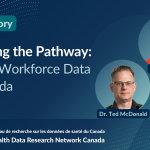Mapping the pathway to health workforce data in Canada


Data are critical for strengthening Canada’s health workforce, and HDRN Canada plays a key role in unlocking access to these data for multi-regional research.
HDRN Canada Executive member Dr. Ted McDonald and Carrie-Anne Whyte, Program Lead for the Data Access Support Hub / DASH showcased the unique data available through the DASH service at a special workshop convened by the 2025 Canadian Association for Health Services and Policy Research (CAHSPR) conference. These data include registries on health professionals, data on physician payments and activities, workforce retention, demographics, social determinants of health, patient and health outcomes, educational and service delivery pathways, and worker compensation trends.
We need to use the data we have, but also plan for the future of Canada’s health workforce with forward-thinking data strategies. Things like anticipating trends, modelling scenarios, and preparing for system changes are all crucial areas for development. ~ Carrie-Anne Whyte
Co-hosted by the CAHSPR Health Workforce Theme Group and Canadian Institute for Health Information (CIHI), an HDRN Canada member organization, the workshop brought together organizations from across the Canadian datascape to showcase available health workforce data and to foster dialogue around data access and use. “It was an important opportunity for the Canadian Institutes for Health Research (CIHR) and leading pan-Canadian data and research organizations to discuss the rich data sets currently available across the country and identify ways to optimize data use in health workforce research and planning,” said Dr. McDonald.
“Are there challenges? Sure,” he continued. “We need to improve data literacy among decision-makers, health system leaders and health professionals—and groups like the Canadian Health Workforce Network are doing that through stakeholder education. We also need visible champions to advocate for better data use and to drive cultural change toward evidence-informed decision-making.”
Other workshop takeaways centred on the need to make better use of existing data, recognizing that while gaps remain, a wealth of untapped information can already inform policy and planning. “We need to use the data we have, but also plan for the future of Canada’s health workforce with forward-thinking data strategies. Things like anticipating trends, modelling scenarios, and preparing for system changes are all crucial areas for development,” Whyte noted, adding that organizations like HDRN Canada, CIHI, Statistics Canada, and Health Workforce Canada are integral players in supporting health workforce data access and use. “Regulatory reform to address privacy barriers is also essential for realizing the full potential of health workforce data,” she added. “Distributed analysis, which enables multi-regional research without physically pooling data and crossing provincial and territorial privacy legislation, will be key to this.”
To learn more, check out Strengthening Canada’s Health Workforce Through Data: Insights from the CAHSPR 2025 Workshop, by Dr. Ted McDonald and Carrie-Anne Whyte.
